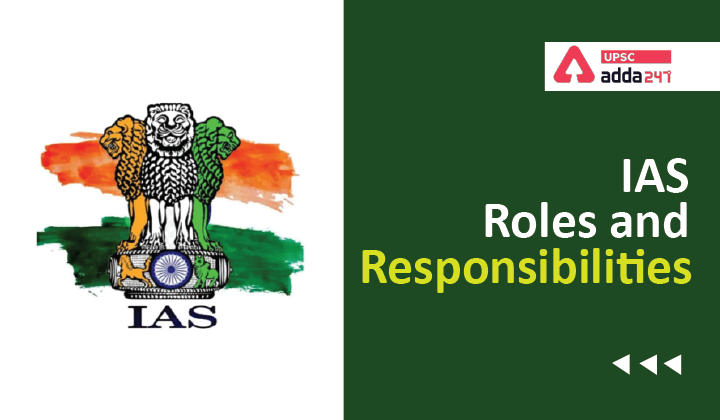Table of Contents
IAS Roles and Responsibilities
“How to become an IAS Officer?” is a question that crosses the minds of many in our country. The role of an IAS officer is incredibly diverse and challenging, making the IAS salary a secondary motivator. The responsibilities of an IAS officer are deeply rooted in a sense of duty and conscientiousness. If you’re someone who thrives on recognition and enjoys taking on leadership roles, then this career path may be the perfect fit for you. In this article, we will delve into the roles and responsibilities of an IAS officer, providing insight into their powers and limitations.
Life of an IAS Officer
An IAS officer possesses the capacity to instigate a constructive transformation in society, one that is eagerly sought after for progress. Given the pivotal position that an IAS officer occupies, it is safe to assert that the responsibilities of the role can be demanding yet ultimately fulfilling, if not inherently exhilarating.
IAS Training
After successfully completing the rigorous selection procedure, an IAS officer joins the Lal Bahadur Shastri National Academy of Administration (LBSNAA) for training.
- Schedule at LBSNAA
- Wake up – 5:30 am
- Morning exercise/horse riding training – 6 am – 7 am.
- Academic activities (lectures, sports, extra-curricular, etc.) – 9:30 am onwards: Generally, it involves 8-10 hours of activities.
- After the activities, the officers are free to socialize and prepare for the next day. The training of IAS officers also includes Bharat Darshan (a study tour of India).
IAS Facilities
Apart from the lucrative salary that an IAS officer gets, he/she also becomes eligible for various allowances like residence, electricity bills, transport facilities, study leaves, lifetime pension, and many more such benefits.
Responsibility of an IAS Officer
The responsibilities of an IAS officer encompass various crucial areas:
- Government Affairs: They handle government affairs, which include policy formulation, execution, and feedback mechanisms.
- Consultation and Collaboration: IAS officers collaborate with different departments and elected representatives to collectively drive developmental initiatives.
- Financial Management: They manage public funds allocated for the effective implementation of various programs and schemes.
- Supervision: IAS officers oversee the execution of government policies and schemes.
- Emergency Response: They coordinate and lead relief operations during emergencies, such as natural disasters, major accidents, and civil disturbances. For instance, the responsibilities of IAS officers expanded significantly during the COVID-19 pandemic.
In addition to these general responsibilities, IAS officers perform specific roles based on their postings:
- Field Assessment: Field postings, often considered the most challenging, are the initial assignments for newly trained IAS officers.
- Subdivision Level: As sub-divisional officers, they focus on maintaining law and order, facilitating development, and managing administrative functions.
- District Level: When serving as district officers, collectors, or deputy commissioners, IAS officers continue their work at the sub-divisional level and oversee the activities of sub-divisional officers.
- State Secretariat/Public Sector Undertakings: IAS officers, after field postings, often work at the State Secretariat. Their firsthand experiences assist in advising elected representatives on policy formulation and government decisions. Additionally, some officers are deputed to public sector units (PSUs), where they play crucial roles in PSU management.
- Central Secretariat: After State Secretariat assignments, IAS officers typically serve in secretarial-level positions for various central government ministries. At this level, they engage in policy review, formulation, and implementation at the national level.
Powers of an IAS officer
During the pre-independence era, a district collector was known as the ‘maai-baap’ of the district administration. Rightly so, the powers of an IAS officer have been codified through nearly 300 laws. These have been summarized in All India Service Manuals, which the Department of Personnel updates from time to time. Some of these laws are:
Code of Criminal Procedure (1973): Sections 107,108,109,110,133,144 and 176 list the powers granted to the magistrates to maintain law and order.
Tenancy laws mention a collector’s income powers.
National Disaster Management Act lists the powers of Chief Secretaries and Magistrates in directing operations for disaster relief. In COVID, this Act was widely used.
Arms Act, Drug Licenses Act, Essential Commodities Act, etc. list the powers of IAS officers to enforce regulations in critical situations.
However, one should not think that these powers are unrestricted. An officer can exercise their powers under these laws, but they are bound to the IAS rules and regulations and therefore, are accountable to the legislatures of state and central government for their actions.
| Relatable Articles | |
| UPSC Syllabus | IAS Salary |
| IPS Full Form | Indian Administrative Services |
| Indian Foreign Services | Director of Intelligence Bureau |




 TSPSC Group 1 Question Paper 2024, Downl...
TSPSC Group 1 Question Paper 2024, Downl...
 TSPSC Group 1 Answer key 2024 Out, Downl...
TSPSC Group 1 Answer key 2024 Out, Downl...
 UPSC Prelims 2024 Question Paper, Downlo...
UPSC Prelims 2024 Question Paper, Downlo...




